Mycosis of failure is an infection that is associated with a cosmetic defect and a number of clinical symptoms.Pathological changes are related to the layer of the skin and nail plate.The causative agent of mycosis are representatives of the lower classes - fungi.The infectious process is dangerous not only for the patient himself, but also by the loved ones around him.How to prevent nail mycosis and get rid of infection will be discussed.
Mikose of nails in the legs - what is it?
The legs are called onychomycosis, and refer to a special classification of diseases.Recently, complaints about the infection have increased several times.Doctors associate this indicator with unhealthy ecology.
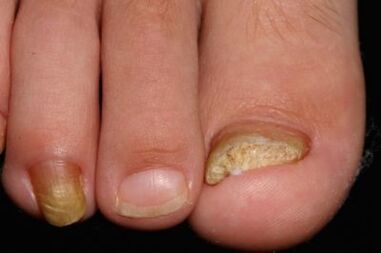
Onychomycosis is a disease in which the structure of the nail plate and the epidermal layer is concerned.The surrounding fabrics (skin roller) are included in the pathological process.The nail is arranged in such a way that the cells are tightly pressed against one another, forming a dense surface.Under the nail plate, matrix and blood vessels, surrounding the phalanx of the bone.The upper layer is represented by hyponichia, and at the base of the nail there is eponichia.With the nail mycosis, the pathogen affects the bottom layers of the nail until the matrix.At the same time, partition cells destroy keratocytes and the nail plate becomes diluted and fragile.Onikomycosis, in the absence of treatment, is associated with various complications, and it is difficult to deliver to modern therapy.
It is known just over 50 types of fungal infections that are dangerous to humans.All of them have different morphological traits and parasitic phases.To eventually identify the pathogen, a mandatory microscopic examination is performed.
The walking nails are necessary to protect the soft parts of the fingers from the damage.Fashionistas paint nails of different colors, so mycosis is also considered a cosmetic defect.With onycomycosis, the appearance of the nail deteriorates.The nail plates explode, break down and completely destroy.The disease provokes a deterioration of chronic systemic pathologies.
By penetrating the nail layer, the causative agent begins to actively split, releasing new and new fibers of the mycelius.Due to the lack of air, mycelium applies to healthy nail and skin areas.The disease should be diagnosed and treated.
Types of disease
Some types of pathogens are distinguished, which affect the feet on the feet.Classify parasites according to morphological traits and clinical signs.
- Trichophyte is red - a fungus that has a branch and disagreement on the mycelium strands.The localization of the process falls into the epidermis, a gross (keratinizing) part of the cells.A specific feature of red trichophyton damage is the strictness of fabrics.Lightweight points and lines are different, and then merge.In the thickness of the skin cells, the mycelium is compact, stretches and forms disagreements that can resist the methods of different treatment.When staining the nail medicine in a microscope, the trichofitone structure is clearly visible.
- The epidermofite is formed -microorganism that causes nail mycosis in the form of skin peel, itching of inter -reagents and nail stratification.Unlike Trichophyton, the epidermophyton grows in several directions of their spore cell, so the localization of the process is unclear.Mycelium of different thicknesses: from delicate thin to wide and short.When studying a microscopic drug, spores and part of the mycelium are compared to flakes.Epidermofite infection is associated with a change in nail pigmentation and its gradual destruction.The infectious process begins both from the edge of the nail plate and its base.In addition to the jaundice of the patient's nail plate, increased dryness and rapid keratinization are disturbed.
- Mentagrofitest is one of Trichophyton's bright representatives.It is less common, affects the skin of the feet, the nail polish and the nail plate itself.The causative agent penetrates the bottom layers and is able to reach the submarine epidermis - matrix.Causes a seal of the layer of layer and thick of the delicate parts of the nail.Statistics show that almost 20 % of the fungal infection falls on Trichophyton MentaGrofitest, 80 % is Trichophyte rubrum.Mentorrofit -induced onycomycosis contributes to the development of allergies, the formation of vesicles and bubbles of the affected epidermis.
- Trichophyte rubrum is a microorganism resistant to external factors, but most often affects the skin of the feet.The causative agent for a long time is in the patient's shoes and socks.In most cases, it is found along with other representatives of onycomycosis.
- Yeast microorganisms are most famous as a candidate.Candidiasis is found on nails, skin and mucous layers.With nail mycosis, candidates cause specific symptoms and varying degrees of destruction of keercitis.After conducting research, scientists concluded that the candidate rarely becomes the leading cause of mycosis, however, against the backdrop of a decrease in local immunity, fungi are inserted into nail microtrauma and "distributes" disputes.The mushrooms of the mushrooms are long, thin, branched.In a microscopic growth, the Mickel scaffold and a lot of disputes are found.Candida -induced onycomycosis is associated with wound formation, a change in the shape and color of the nail.Candida's preparation is one of the types of candidacy.An obvious feature of the disease is the main formation of a dark place on the surface of the nail.In the future, the place grows - the nail becomes fragile and leaves the matrix.
- Skopulariopsis is a less common type of nail mycosis.Similar to candidacy, but there are also significant differences in morphology.Small black spots appear on the surface of the nail plate.In the thickness of the nail, the formation is much wider and darker.The spread of points leads to relaxation and destruction of the nail.
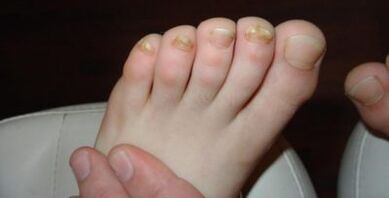
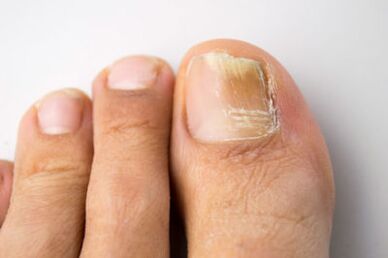
The characteristics of the pathogen species contribute to the correct diagnosis of the disease.However, to make a final diagnosis, it is not enough to recognize the clinical features of the infection.For this, the pathogen should be differentiated.
Causes
The main reason for onycomycosis is the penetration of fungi into keratocytes or epidermis.This process arises for the following reasons:
- a weakened immune system due to prolonged use of antibacterial drugs (general and local action);
- Direct contact with infection: ordinary home articles, visiting pools or public saunas;
- the presence of chronic diseases of the endocrine system and the thyroid gland;
- Systemic pathologies of extremity veins: thrombosis, atherosclerosis, varicose extent, tendency for thrombophlebitis;
- herpetic infection that contributes to the decline in body protection;
- Gastrointestinal diseases and muscle pathologies;
- Age -related changes.
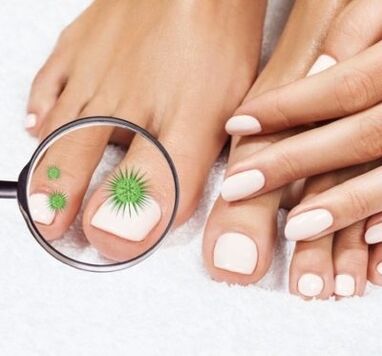
Nail mycosis can be the result of incorrectly selected shoes and drawers.
Pay attention!Wearing synthetic quality socks leads to lack of air, which creates the "soil" for the spread of mycosis.
Shoes and tight shoes are not seasonal, lack of toe hygiene, and the use of common manicure tools often leads to onycomycosis compared to chronic diseases.
Symptoms
You can suspect nail mycosis in the presence of signs such as:
- Itching and minor burns.
- Skin bark and redness of interdigital space.
- Tightening the nail and appearance on the surface of small points, cracks or strictness.
- An unpleasant odor and pain appears with effort on your fingers (when you run, walk or shoes).
The pathology develops rapidly, and after a little time the patient worries about fragility, relaxation and pigmentation of the plate.In the absence of treatment, a yellow-green or dark brown tinge, roll hyperemia, epidermis burn and disappearance of nail glow.All of these signs show different degrees of nail damage.
The degree of injury to the legs
Nail fungi on the foot are classified according to the degree of intensity of clinical signs.There are only three degrees of pathology:
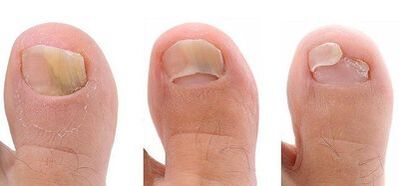
- Initial or normotrophic scale.The focus of the infection falls on the extreme fingers.The tile has a light layer or light pigmentation.
- The hypertrophic scale is characterized by the development of clinical signs.Patients mark pain, increased sweating and the presence of unpleasant odor.The nail is compressed and vibrant.
- Atrophic scale is the most dangerous form of pathology, as all layers of nail and matrix are included in the pathological process.Atrophic changes are captured by nearby skin parts and a roller.Due to considerable destruction, the risk of bacterial infection and the development of purulent processes increases.Treatment processing can lead to sepsis or bacteria.
The type of disease is extremely important for a doctor, as it allows you to determine the method of treatment and prevent complications.
Troubleshooting
Diagnosis or mycologists are engaged in diagnostics as well as treatment of the disease.To confirm the diagnosis, special studies are performed:
- microscopic study of a piece of nail or scrap;
- Nourishing media planting for the growth of the pathogen and the choice of therapy;
- Histological study of skin medicine to assess the degree of severity.
The doctor performs an external examination, collects the patient's history and his complaints.If necessary, it recommends doing a general blood test.
Diagnostic manipulations take some time because part of the nail is set in special solutions to distribute cellular elements and studying pathogenic morphology.It is impossible to make a diagnosis only with external signs, we can only assume a pathogen.
After complete diagnosis and evaluation of the severity of the disease, the treatment method is determined.
Treatment of nail mycosis on foot
The nail mycosis therapy depends on the patient's condition and the degree of destruction of the nail plate.The main purpose of treating nail mycosis is to completely annihilate the patient from the pathogen and constant restitution.Treatment tactics and therapy method are determined by the doctor.
potion

The most common method of treatment is the use of medicines.The following pharmaceutical groups are used in therapy:
- Paulines are tablets that destroy the DNA of the parasite and its mycelin.It is recommended to receive funds for at least 14 days.
- Azols are medicines that inhibit the growth of pathogenic agents and prevent their reproduction.
- Alllamins are long -acting medicines used in advanced stages.Due to the minimum of contraindications, the medication is successful.
The above drugs have several dosage forms: tablets, capsules, creams and spraying.Antifungal therapy is performed both internally and externally.The course of treatment is determined by the doctor.In addition to specific remedies, antiseptic solutions for washing, antibiotics and wound healing are prescribed.Doctors gradually advise to get rid of the affected plate: cut or cut the edges, use a special piece.
Surgery
If conservative treatment has not yielded positive results, then they turn to the operation.The intervention is performed using laser rays to suppress the growth of the pathogenic microflora.The procedure is performed in several stages.
Traditional medicine
Non -traditional recipes are used to rinse wounds and increase local immunity.It is impossible to eliminate fungi with popular methods, but it is possible to weaken the mycosis pathogen.
- The most famous and common method is bathroom baths and compresses with tar.
- Famous baths with sodium bicarbonate and salt - eliminate bacteria and exercise antiseptic properties.
- Lemon juice and propolis.The nail is lubricated with juice, and a compress is prepared by propolis.
- Cerandine juice and watery vinegar.
- Iodine lotions.
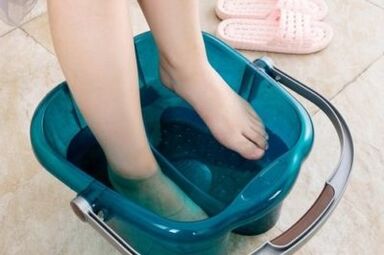
However, popular methods are used together with the treatment of medicines to prevent complications, non -traditional treatment methods with a physician should be coordinated.
PREVENTION
Preventive measures can avoid infection and reduce the risk of relapse of the disease.The patient should eat properly, observe the toe hygiene, not to wear someone else's shoes or use an ordinary towel.When visiting saunas or pools, put on personal rubber slippers and rinse them completely at home.
Foot nail mycosis is an unpleasant and dangerous disease.The infection can penetrate deeper layers and impress the nail plate and matrix.It is easier to prevent the disease than to be treated, but when infected, the patient should seek as soon as possible for qualified help.Creams, varnish and special tablets allow you to stop growing mycelium and destroy the cell wall.It is important to understand that the treatment is long, so you have to wait for the therapeutic effect no earlier than 3 weeks.























